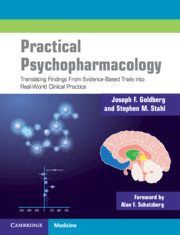 Practical Psychopharmacology
Practical Psychopharmacology Book contents
- Practical Psychopharmacology
- Practical Psychopharmacology
- Copyright page
- Dedication
- Contents
- Foreword
- Preface
- Abbreviations
- Part I General Principles
- Part II Targets of Pharmacotherapy
- 13 Disordered Mood and Affect
- 14 Disorders of Impulsivity, Compulsivity, and Aggression
- 15 Psychosis
- 16 Deficit States and Negative Symptoms
- 17 Anxiety
- 18 Addiction and the Reward Pathway
- 19 Trauma and Post-traumatic Stress Disorder
- 20 Personality Disorders and Traits
- 21 Cognition
- 22 Putting It All Together
- References
- Index
22 - Putting It All Together
from Part II - Targets of Pharmacotherapy
Published online by Cambridge University Press: 19 October 2021
- Practical Psychopharmacology
- Practical Psychopharmacology
- Copyright page
- Dedication
- Contents
- Foreword
- Preface
- Abbreviations
- Part I General Principles
- Part II Targets of Pharmacotherapy
- 13 Disordered Mood and Affect
- 14 Disorders of Impulsivity, Compulsivity, and Aggression
- 15 Psychosis
- 16 Deficit States and Negative Symptoms
- 17 Anxiety
- 18 Addiction and the Reward Pathway
- 19 Trauma and Post-traumatic Stress Disorder
- 20 Personality Disorders and Traits
- 21 Cognition
- 22 Putting It All Together
- References
- Index
Summary
We have, we hope, covered a large but not unwieldy swath of territory of practical relevance for the everyday clinician trying to make pharmacological decisions informed by evidence. As illustrated throughout the preceding pages, the availability of empirical data to guide treatment decisions varies greatly within and across disorders. It probably matters more that clinicians know how to think empirically – that is, knowing when, where, and how to look up information pertinent to a given case – rather than try to tackle the impossible task of comprehensively knowing the ever-changing clinical trials database for all disorders. Wisdom equally involves recognizing when evidence is lacking, prompting reliance on opinion, extrapolation, and plausible rationales – but not conflating those guideposts with an empirical database.
It is time now to cull the principles we have tried to illustrate and summarize what we would consider to be basic maxims for practical psychopharmacology.
- Type
- Chapter
- Information
- Practical PsychopharmacologyTranslating Findings From Evidence-Based Trials into Real-World Clinical Practice, pp. 500 - 507Publisher: Cambridge University PressPrint publication year: 2021
